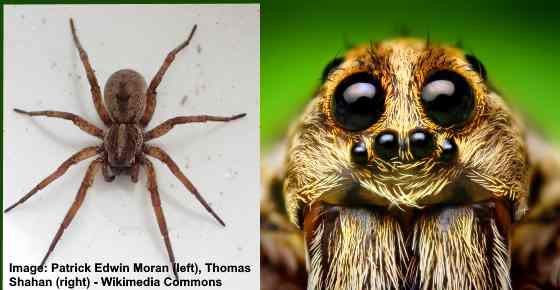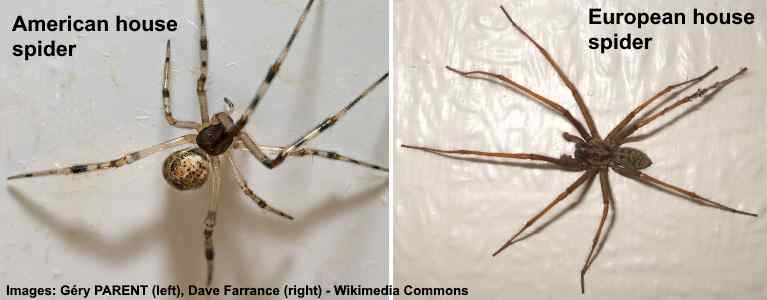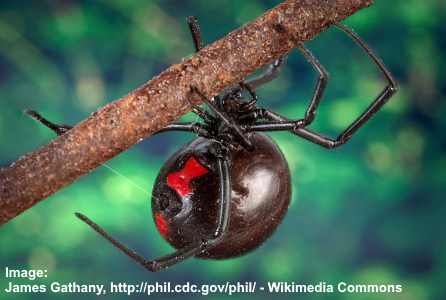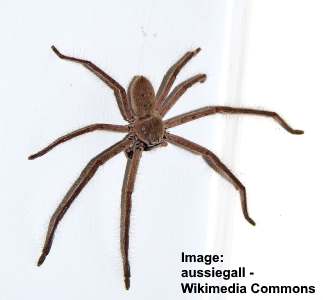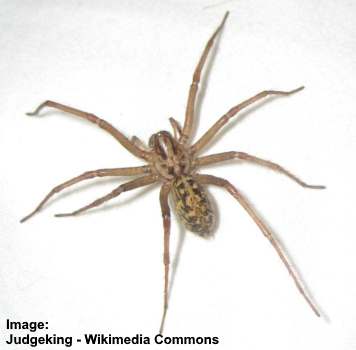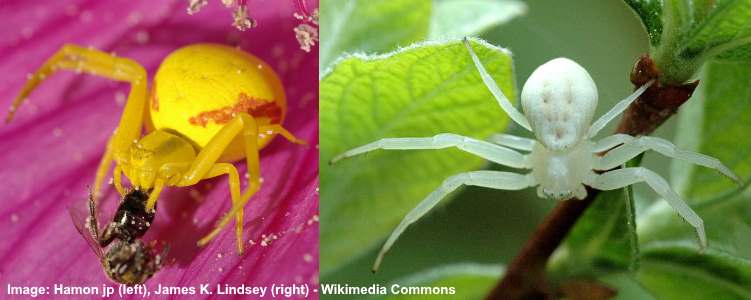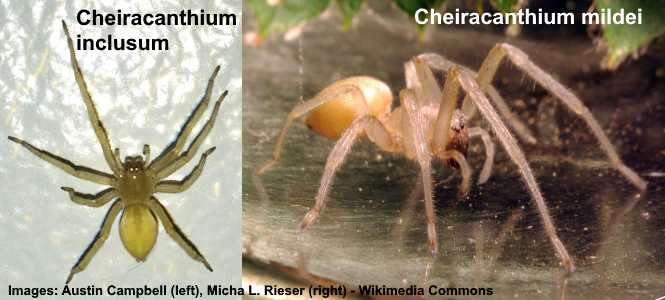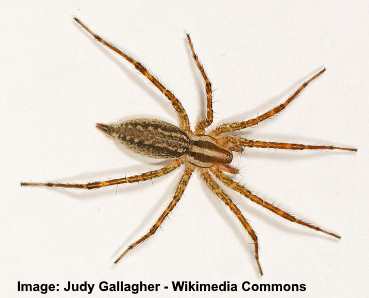Types of Spiders and How to Identify Them (Pictures, Names, Identification Chart)
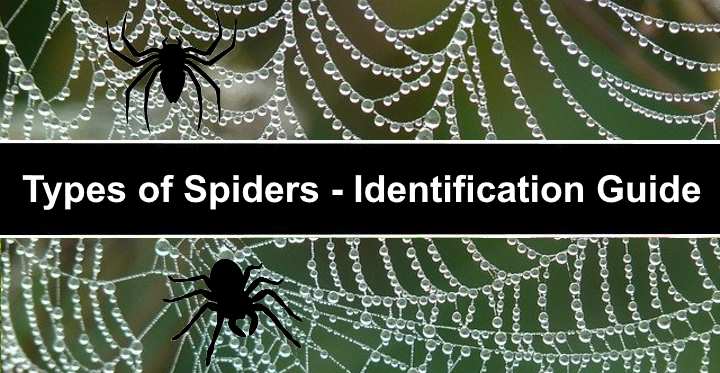
Many types of spiders can instill fear as they scurry across a room or jump out from a dark corner. Even though most species of common house spiders are harmless animals and don’t bite, few people like seeing them. The most common 8-legged arachnids that live in houses are brown spiders. Among the more than 48,000 species of spiders are black spiders, brown and black spiders, little red spiders, and even white spiders.
Spiders are arthropods that belong to the class of animals named Arachnida and order Araneae. Spiders are grouped into various genera. These genera include species such as funnel-web spiders, orb-weaver spiders, sac spiders, wolf spiders, and hunting spiders. Some of the most frightening spiders are tarantulas in the Theraphosidae family.
Many species of venomous spiders are black and red spiders. The most famous is the black widow spider that can cause a non-fatal nasty bite. However, venomous spiders can also be brown, black with white spots, or black with a red body.
It is important to identify the correct species of spider to tell harmless house spiders apart from ones that bite. The good news is that most spiders you find in your home or garage won’t do any more harm than give you a fright.
Spider Facts
Before looking at pictures of spiders and how to identify them correctly, there are a few important facts to know about spiders.
All spider species are called arachnids because they belong to the class of animals called Arachnida. This large group of leggy animals also includes mites, ticks, and scorpions. One of the identifying features of all spider arachnoids is that they have 8 legs and no antennae.
This means that spiders are not classified as insects. Although spiders and insects are arthropods, insects only have 6 legs and are in the class Insecta. Another difference when identifying spiders is that they have 2 body parts whereas insects have 3 body parts.
Because spiders are invertebrates, they don’t have bones but have an exoskeleton. This is a type of external skeleton that covers, supports, and protects spiders, ants, wasps, bees, roaches and even lobsters!
Although many people refer to spiders as bugs, they are not classed as bugs. In fact, not all types of insects are bugs because they don’t have a mouth that sucks juices. However, most people refer to any type of house pests such as spiders, ticks, mites, and flies as bugs.
How to Identify Spiders
You can identify spiders by their eight legs, the color of their abdomen and cephalothorax (head), six or eight eyes, and mouthparts (chelicerae). In addition, some spiders have identifiable markings such as spots, dots, or spiny bodies and legs.
It’s also possible to identify species of spiders by the webs they spin. Some spiders are known as tangle web spiders that spin messy webs. For example, white orb spiders spin beautiful circular webs to catch prey. Other spider species spin funnel webs for protection or laying eggs.
Types of Spiders With Names and Pictures – Identification Guide
Let’s look in more detail at the identifying features of the most common species of spiders that you are likely to find at home or in your garden.
While there are big fat black species of spiders such as tarantulas, mouse spiders, or trapdoor spiders, this list looks at the most common spiders you will find in and around your home.
Wolf Spider
Wolf spiders are a subclass of arachnids belonging to the family named Lycosidae. There are thousands of spider species that are classed as ‘wolf spiders.’ The bodies of these hairy 8-legged creatures grow up to 1.38” (35 mm).
There are a number of ways to identify the common wolf spider in your home. Shining a light on them may cause an eerie glow from their eyes as the light reflects back. Also, wolf spiders are the only species to carry their tiny baby spiders (spiderlings) on their abdomen.
Wolf spiders bite when they are threatened. However, their bite is similar to a bee’s sting and may cause itching, swelling, and mild pain.
Wolf spiders get their name from the way that they capture their prey. They don’t spin webs but hunt and ambush prey like wolves do.
Spider identification: A type of brown spider with beige markings and quite hairy. In relation to other species of spiders, wolf spiders have large eyes and excellent vision.
You can identify wolf spiders by their distinctive eye pattern. First, you will notice two large eyes in the front of their head. Under those two eyes are a row of four smaller eyes. Wolf spiders also have two more eyes on the top of their head at either side
They are found in most outdoor habitats throughout North America and may come into homes in fall when the weather cools.
The wolf spider species Hogna carolinensis is found in South Carolina.
Brown Recluse Spider

Brown recluse spiders tend to be thinner and less hairy than wolf spiders and their bite is more serious
One of the most dangerous arachnids to find in your home is the brown recluse spider (scientific name: Loxosceles reclusa) from the family Sicariidae. Like with other species of recluse spiders, a bite from one of these brown arachnids can require medical attention.
Spider Facts
Excluding their 8 legs, brown recluse spiders range in size from 0.24” to 0.79” (6 – 20 mm). Due to their violin-shaped markings on their rear, they are also called ‘violin spiders,’ ‘fiddleback spiders,’ or ‘brown fiddlers.’ Their long spindly legs make them look bigger than they actually are.
Unlike most other spiders, brown recluses have 3 pairs of eyes rather than 4. They usually scurry away when they feel threatened but if cornered, they may bite. This can result in serious skin tissue injury if not treated properly.
Spider identification: Brown recluse spiders can be tiny in size or grow to be large spiders nearly an inch (2.5 cm) long. They are usually light tan to medium brown and some species can be dark brown or gray.
These spiders prefer isolated locations and create webs in garages, woodpiles, sheds, and cellars. They are found in many states in central and eastern U.S. such as Texas, Nebraska, Ohio, Georgia, and Kentucky.
American House Spiders
One of the most common house spiders is the American house spider (Parasteatoda tepidariorum). These brown or tan harmless spiders usually create messy cobwebs to catch their prey.
American house spider facts
These are generally a small species of spider with average body sizes of 0.25” (6 – 7 mm). Although these small house spiders are classed as a type of brown spider, the darker species may resemble black widows. However, dark-colored common household spiders don’t have red markings and won’t give you nasty bite.
Other species of spiders in other countries are also called ‘common house spiders.’ The European domestic house spider (Tegenaria domestica) is a brown spider found in Europe. It was also introduced to the US and you can find this house spider in states such as Louisiana, Oregon, Michigan, North Carolina, Washington, and New York.
Spider identification: Found throughout North America, these common spiders are generally found in basements, in attics, behind doors, and in the corners of window frames. The legs of the American house spider are often yellow/orange with dark rings.
Black Widow Spiders
Black widow spider is the common name for spiders in the Latrodectus genus belonging to the family Theridiidae. These black spiders with red dots are some of the most venomous house spiders in North America. Another venomous species in the genus is the brown widow spider.
Other species include the European black widows (Latrodectus tredecimguttatus), Australian redback black widows (Latrodectus hasseltii), and South African button spiders.
Spider facts
Black widows are identified by their shiny black body and distinctive red markings on the underside of the abdomen. But they may also have red markings on their backs. The male species can have a black body with red dots and white bands across their bodies.
Although the female black widow spiders can inflict a nasty bite, the bites rarely cause serious complications. Some common effects of a black widow bite are pain, swelling, and cramping. Species of black widow only bite when trapped and threatened.
Spider identification: Species of black and red widow spiders are found on most continents. The red markings on the lower back abdomen often resemble an hourglass.
The North American black widow spiders are generally found in eastern states and are common in the southern states such as Texas, Louisiana, Florida, Oklahoma, and Arkansas.
Huntsman Spiders
Huntsman spiders (family: Sparassidae) are appropriately named because of their speed and agility when looking for prey. Some of the larger species are called ‘wood spiders’ or ‘giant crab spider.’
Spider facts
Huntsman spiders are large hairy spiders that can sometimes be mistaken for tarantulas. They have brown/beige or tan-colored bodies and long legs. Usually, the bodies are just under an inch (2 cm) long and their leg span can be as large as 6” (15 cm). The difference between these venomous arachnids and tarantulas is that their front legs resemble a crab’s pose.
Sparassidae species can attack and bite humans to defend themselves. Because they tend to lurk in sheds, garages, and under rocks in gardens, an unsuspecting person may disturb one and get a nasty bite.
Spider identification: Over one thousand species of huntsman spiders live in warm countries throughout the world. They have furry bodies and are in various shades of brown or gray.
Hobo Spider
The hobo spider (Eratigena agrestis) is a member of the spider genus called Eratigena and is known for its funnel webs. They are also called funnel-web spiders and are a relatively harmless species found in Europe and North America. These brown or beige spiders shouldn’t be confused with highly venomous Australian funnel-web spiders (mygalomorphs).
It can be difficult to identify hobo spiders because of their diverse appearance. They are generally small light to dark brown spiders about 0.27” to 0.55” (7 – 14 mm) in length. One way to identify these little brown spiders is by the yellow markings on their abdomen.
Although some class the hobo spider as an aggressive house spider, they only attack and bite if their young are threatened.
Spider identification: Hobo spiders can resemble wolf spiders or brown recluse spiders. They tend to inhabit dark cracks and crevices in homes, outbuildings, garages, and sheds.
White Spiders
The ‘flower crab spider’ (Misumena vatia) is a white species of spider in the family Thomisidae. These are an unusual small type of white spider that can change its color. These garden spiders get their common name from the crab-like way they hold their legs.
Color changes of white spiders is a camouflage mechanism to catch their prey. The white spiders can turn bright yellow if they are on yellow flowers. In North America, you can sometimes find these crab spiders on goldenrod flowers. Because of their bright yellow colors, they are also called ‘banana spiders.’
Spider identification: These are quite small spiders. Females can grow up to 0.39” (10 mm) excluding legs; males reach half this size at most.
Orb-Weaver Spiders
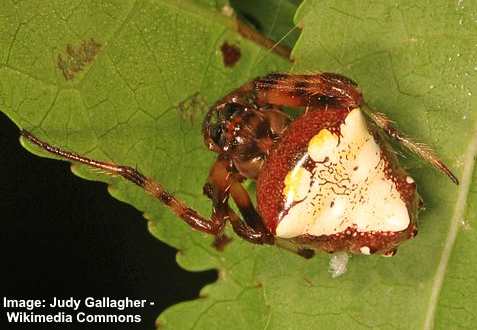
Arrowhead Orb Weaver Spider (Verrucosa arenata) is common in North America in forests, gardens or hiding in dark areas
Some of the most colorful spiders you will find in your garden are orb-weaver spiders. These spiders from the family Araneidae spin some of the most beautiful webs you will come across.
Because all spiders that spin orb (circular) shaped webs are classed as orb-weavers, orb spiders are difficult to categorize as they include many species. Some are oval-shaped with a black and white body and dark red spike-like shapes. Other species can have black bodies with yellow and white markings. Or, an orb-weaver spider could have a large globular colorful body with a small head.
These spiders can also range in size from very small ones to huge spiders that have a leg span as big as your hand.
Spider identification: Harmless spiders that spin intricate webs on flowers, trees, and near electric lights to catch insects.
Jumping Spiders
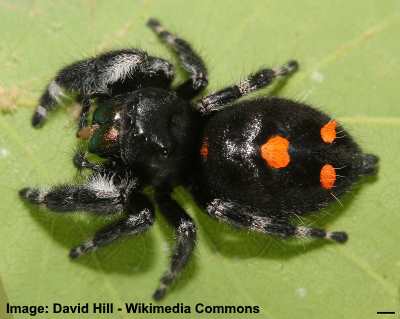
Phidippus audax is a common jumping spider of North America with black body and orange or white spots and stripes on their abdomen and legs
Spiders in the family named Salticidae are called jumping spiders because they jump when moving or hunting. The large eyes on the front of their body mean they also have great eyesight, something rare among other types of spiders.
Jumping spider facts
There are over 6,000 species of jumping spiders divided into 640 genera. Most kinds of jumping spiders have hairy or furry bodies and a distinctly shaped head and thorax. Another way to identify jumping spiders is by their 4 eyes on the front of their head, 2 of which are larger. Their great eyesight allows them to hunt and jump on prey before injecting venom.
Jumping spiders can also be very tiny. Some of the smallest species only measure 0.04” (1 mm) and larger ones are an inch (2.5 cm) long.
Spider identification: These usually small brown spiders are found almost anywhere and can be seen during the daytime.
Sac Spiders
The name ‘sac spiders’ can refer to a large number of spiders in the families Clubionidae, Corinnidae, or Eutichuridae.
One of the most common species of sac spiders is the ‘yellow sac spider’ (Cheiracanthium inclusum and Cheiracanthium mildei). These running spiders are a yellowish-green color and can bite when provoked. The most common reasons for being bitten are disturbing them while working in the garden or if one gets trapped in clothing.
Sac spiders are a garden spider in warm weather and will invade houses in fall as they search for a warmer environment.
These common house spiders are easy to identify as they have a lighter color than brown house spiders.
Spider identification: A tiny species of spider that has a body length of around 0.25” (6 mm) with a distinct light-colored cephalothorax. The name ‘sac spider’ comes from the fact they tend to live in small spun sacs in corners of rooms and windows in homes, outbuildings, or garages.
Cellar Spiders (Daddy Long-Legs)
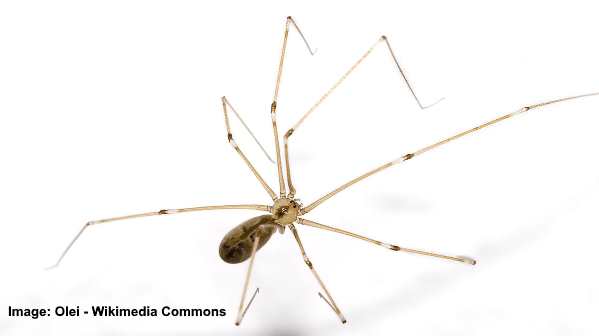
Cellar Spiders are common house spiders. These typical house spiders have long legs and they like to live in dark places
Long-bodied cellar spiders (Pholcus phalangioides) belong to the family Pholcidae. These spiders also have some of the longest legs of any spider in relation to their body. Their long thin spindly legs can be as long as 6 times their body length.
Although these spiders carry venom, they are completely harmless to humans. In fact, they are classed as a beneficial spider because they consume a large number of pests such as flies, mosquitoes, and other flying nuisances. These skinny spiders also kill dangerous spiders such as hobo spiders and redback spiders.
Cellar spiders get their name from the fact they like to live in dark places. You will often find them in garages, on ceilings, in cellars, and in caves. Other names for them include daddy long-legs and skull spiders – this is because their cephalothorax looks like a skull.
Spider identification: Small oval-shaped bodies that are light tan or beige and long skinny legs make this spider species easy to identify.
Grass Spider
Grass spiders are a species of spider belonging to the family Agelenidae. They are a medium sized brown garden spider with striped markings along the length of its body. When trying to identify this spider, you will notice distinct bands around its legs.
Grass spiders are usually found in lawns, parks, and other grassy areas. They have a venomous bite that is fatal for insects but relatively harmless for humans. Because they are another type of beneficial arachnid, it is best to avoid killing them. They will help to keep down populations of mites and other insects in your garden.
Spider identification: If you find the brown spider scurrying around grass, it is probably a grass spider. It is rare to spot these harmless brown spiders indoors.
Female grass spiders range in length from 0.39″-0.78″ (10-20 millimeters), while males are slightly smaller.
Golden Silk Spiders
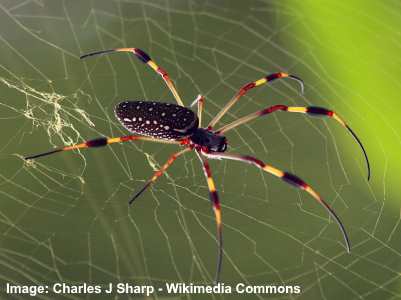
The large Golden silk spider (Nephila clavipes) has long legs with bright colors on the female abdomen
Also called golden silk orb-weavers, these arachnids from the subfamily Nephilinae spin some of the most beautiful webs. Other names for this fascinating spider include ‘banana spider’ and ‘giant wood spider.’
Golden silk spiders are also very colorful spiders that range in color from red to greenish-yellow. Many species also have white markings or spots on their cephalothorax. Another unique fact about this spider species is that they spin yellow-colored webs.
Golden silk orb-weavers are also some of the largest garden spiders you will find in warmer climates. The females can grow as long as 2” (50 mm), not counting the length of their super-long legs. Some Asian species of banana spiders have been recorded at over 5” (130 mm) long!
Spider identification: These large spiders in North America are found in southeastern states such as the Carolinas, Florida, and can even be found in Texas, Louisiana, and Georgia.
To identify these interesting spiders, look for their long orange or dark tan shaped body with white spots.
Learn about common garden spiders and how to identify them.
Bold Jumper Spider (Phidippus audax)
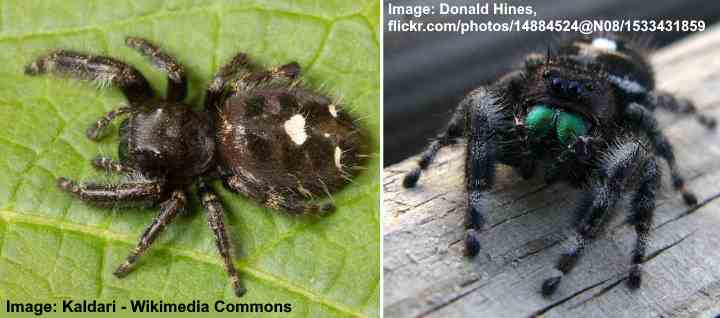
The bold jumping spider is characterized by shiny black body, three white dots on its back and striped hairy legs
Also called the white-spotted jumping spider, the bold jumping spider has a fuzzy black cephalothorax and a black and white oval abdomen. The medium-sized black spider has three distinctive white spots on its back. In addition, there are two rows of darker brown spots on the underside of the spider’s abdomen.
Another distinguishing characteristic of the bold or daring jumper includes fuzzy white hairs covering its black legs. The black and white jumping spider measures 0.25” to 0.75” (6 – 20 mm), and the males are somewhat smaller.
Spider identification: The bold jumper spider is identified by its furry black body and distinctive oval to heart-shaped abdomen with white dots and lines.
Zebra Jumping Spider (Salticus scenicus)
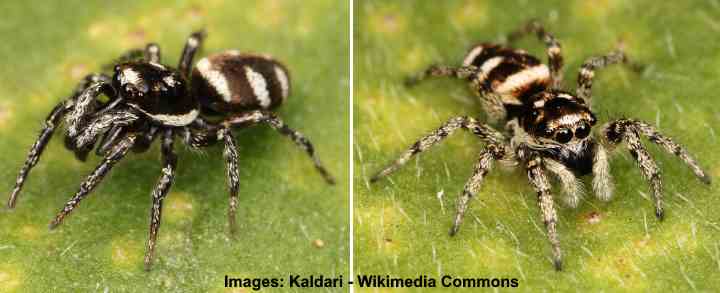
Zebra Jumping spider is a black spider with white stripes on its back. Picture of male spider (left picture) and female spider(right picture).
The zebra jumping spider is a black spider with white stripes on its back. The identifying features of the zebra jumping spider are its dark-black colored body, white stripes across its back, and furry black legs with white spines. You’ll also notice two large eyes on the front of its head.
The zebra jumping spider is classed as a tiny striped spider measuring 0.2” to 0.35” (5 – 9 mm) long. The female zebra jumping spiders are similar size or slightly bigger and with smaller mouthparts (chelicerae).
Spider identification: The zebra jumping spider is a black spider with white spots that can be recognized by its furry black body, two or three pairs of white abdominal stripes, and black and white fuzzy legs.
Eastern Parson Spider (Herpyllus ecclesiasticus)

The eastern parson spider is an aggressive spider with distinctive white markings on its black abdomen
The eastern parson spider is identified by its recognizable white cravat-style marking on its oblong black or brown body. In addition, this aggressive long-legged spider has grayish hairs covering the abdomen and black hairs over its cephalothorax. Adult female eastern parson spiders measure 0.4” to 0.8” (10 – 20 mm) long.
The eastern parson spider is a species of nocturnal hunting spider. Rather than spinning intricate webs, the spider scurries around, looking for small insects to bite and kill. Unfortunately, this venomous spider can also inflict a painful bite in humans that can cause allergic reactions.
Spider identification: The easily identifiable eastern parson spider has an abdominal marking in the shape of an old-style cravat. Other identifying traits include its black and brown legs, black body, and white spot beside its pair of spinnerets.
Spiny-Backed Orb-weaver (Gasteracantha cancriformis)

Spiny-backed orb-weaver is a red, black and white spider with a unique shape
The spiny-backed orb-weaver is a white spider with black dots and six pointed red spines. It’s one of the most unusual black and white spiders due to its oversized oval abdominal section and tiny black head. The crab-shaped spider measures 0.39” to 0.51” (10 – 13 mm) wide and 0.2” to 0.35” (5 – 9 mm) long.
This little black-spotted white spider spins intricate orb-shaped webs to catch its prey. The unusual spider is common in Florida and is also found throughout North and Central America. You’ll often find the spider in gardens resting on their webs on shrubby plants.
Other species of these colorful spiders can be gray and black, yellow and black, or red, black, and white.
Spider identification: The spiny-back orb-weaver is recognized by its white body covered in black spots. Other identifying features are six conical spikes, black legs and underside, and fuzzy white spines on its body and legs.
Western Black Widow Spider (Latrodectus hesperus)

Western black widow spiders: female (left) and male (right)
The male western black widow is a harmless, brown-colored spider with white stripes on its abdomen. Unlike the adult female, the male species has an oblong rather than bulbous body. Additionally, although male widows bite, the effect isn’t as severe as a bite from a female black widow spider.
Because of its brown to tan coloring, it’s easy to mistake a male western black widow for a brown recluse house spider. This species of brown spider is relatively small, only measuring 0.27” to 0.31” (7 – 8 mm) long. However, its long leg span of 1” to 1.5” (25 – 38 mm) makes the western black widow appear larger.
Spider identification: To identify the western black widow, look for the dark brown cephalothorax, tan abdomen with a central white stripe, and several lateral lines.
Raft Spider (Dolomedes fimbriatus)
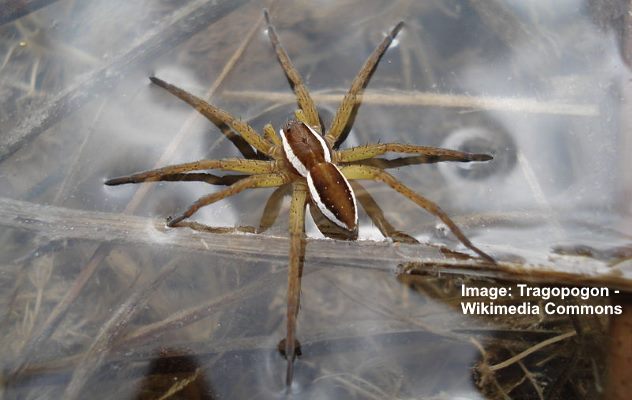
The raft spider has distinctive white stripes along its brown body
The raft spider is a large brown spider with white and black stripes along its oval body. The adult spiders are dark brown to orange and have long legs. These aquatic spiders are often found in wetlands and near freshwater pools. The brown spiders measure 0.35” to 0.87” (9 – 22 mm) long.
Adult raft spiders with their chocolate-brown body look relatively large due to their huge leg span of up to 2.8” (70 mm).
Spider identification: A raft spider has an identifiable creamy white band running the length of its abdomen and cephalothorax. The brown hunting spider has orangey-brown legs. It is classed as a semi-aquatic spider.
Marbled Orb-Weaver (Araneus marmoreus)

Marbled orb-weaver spider: female (left) and male (right)
The marbled orb-weaver is an unusual type of orange spider with a large bulbous abdomen. The orange spider has yellow, pale orange, and black marbling patterns on its back and around its abdomen. The marbled orb-weaver spider also has striped legs with black bands at the joints.
The easy-to-identify orange marbled orb weaver looks like a tiny pumpkin scurrying around on black and white legs. The spider’s appearance is why it’s called the pumpkin soldier spider. The large orange spider measures between 0.35” and 0.79” (9 – 20 mm).
Adult male marbled orb-weavers look different from the females because they have an oval, cream-colored abdomen with dark orange and brown zig-zag patterns.
Spider identification: The marbled orb-weaver is easy to recognize due to its bright orange coloring, ball-like bulging abdomen, and large orange mouthparts.
Cardinal Jumper (Phidippus cardinalis)
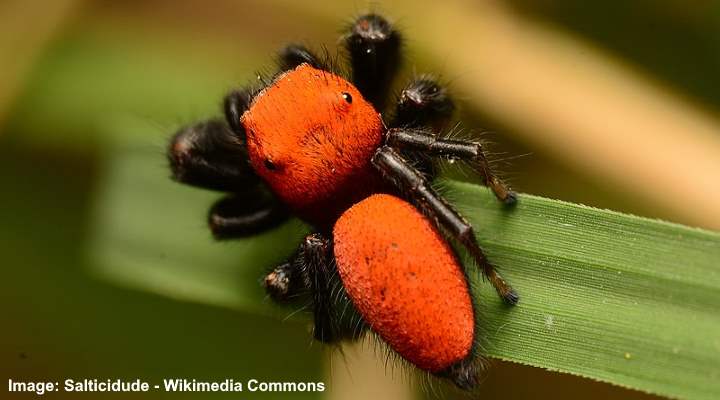
The cardinal jumper has a red-orange furry body with black hairy legs
The cardinal jumper is a tiny fuzzy red-orange and black spider that only measures 0.4” (10 mm) long. The little spider has a spine-covered orangey-red body with jet-black spiny legs. Like other jumping spiders, the legs appear tucked under the body rather than outstretched.
A characteristic trait of this black and dark orange or red spider is that it looks like a furry ant. This is because the jumping spider mimics a type of wasp called velvet ants.
The difference in appearance between the adult male and female spiders is that the females are large and have a grayish appearance rather than black.
Spider identification: To identify a cardinal jumper, look for its brightly-colored orange to red cephalothorax and abdomen, two large central eyes, and spiny body and legs. The female cardinal jumper spiders also have white dots and two dark bands on their backs.
Brown black widow spider (Latrodectus geometricus)
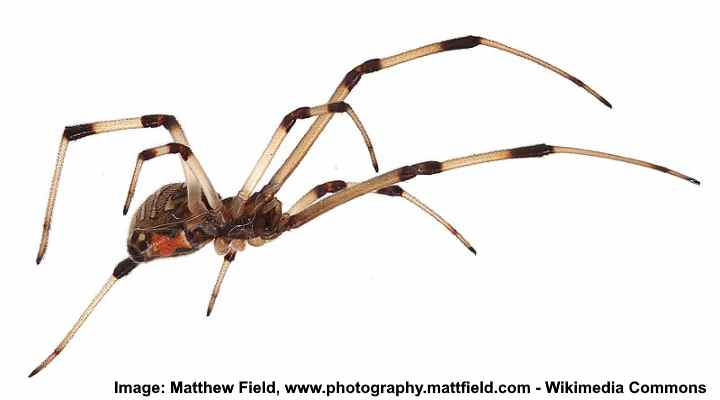
The brown black widow spider has striped long legs and dark orange hourglass marking on its underside
The brown black widow spider has distinctive striped legs and the characteristic orange hourglass marking on its abdomen. The long-legged brown spider also has unique geometric patterning on its abdomen, helping to distinguish it from other widow spiders. The small brown spiders measure 0.47” – 0.6” (12 – 16 mm) long.
This venomous brown spider can inflict a painful bite like a bee sting but is not as severe as a black widow bite.
Other names for these venomous brown spiders include brown button spider, house button spider, or brown widow.
Spider identification: Identification traits of the brown black widow spider are a vivid orange or yellow marking on its abdomen, striped legs, and tan-colored bands across its dark brown body.
Dwarf Spider (Hypselistes florens)
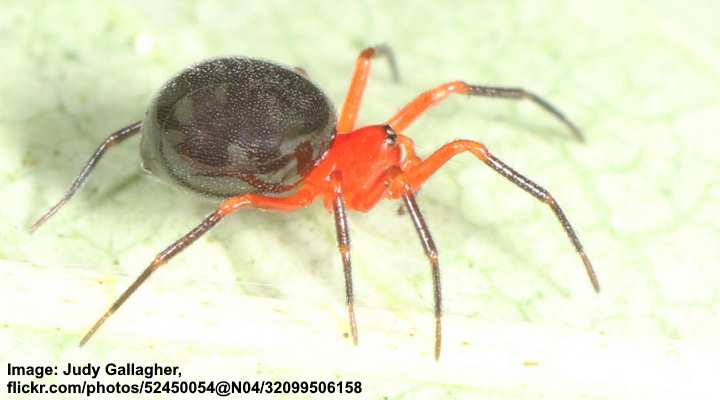
The dwarf spider is identified by an orange-reddish head and rounded black abdomen
The dwarf spider is a type of tiny orange and black spider with thin brown legs, a bulbous black abdomen, and a brightly colored orange head. Up close, you’ll notice that the orange cephalothorax has two rows of four black eyes and frontal pedipalps that look like boxing gloves.
The appropriately named dwarf spider is a tiny spider species measuring 0.11” (3 mm) long.
Spider identification: The dwarf spider is easy to identify due to its dark orange and black body, brown legs, and a bulbous abdomen.
Giant House Spider (Eratigena atrica)
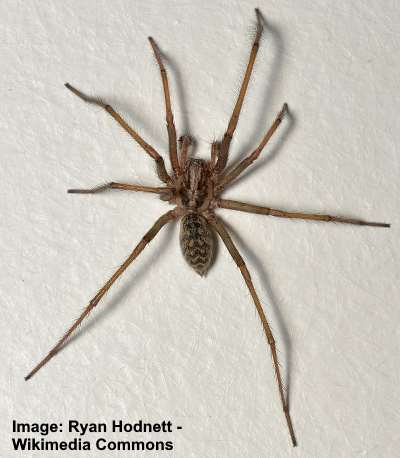
The giant house spider has a brown furry body with lighter markings and long legs
The giant house spider is a common brown spider with an oval, dark brown furry body and long legs. The identifiable features of the brown house spider are the light-colored arrow shapes on its abdomen and fuzzy, spiny brown legs. The huge spider grows 0.73” (18.5 mm) long with a leg span of 3” (75 mm).
Spider identification: To identify this common house spider, look for its dark brown furry body, long brown spiny legs, and two rows of four eyes. You can also tell this brown spider by the messy webs it spins in dark corners of houses.
American Grass Spider (Agelenopsis)
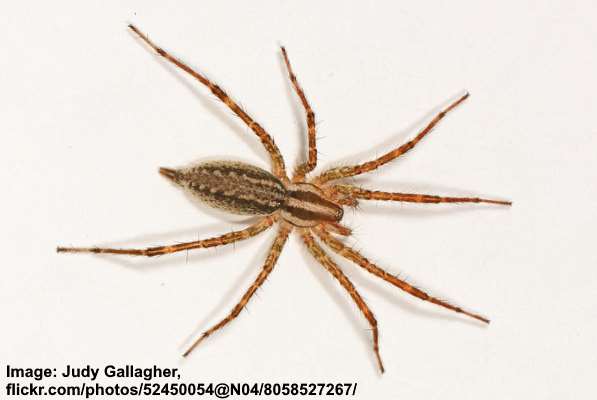
The American grass spider has a light brown body with dark brown stripes and brown patterns on its body
The American grass spider is a type of brown garden spider with tan stripes and a central abdominal patterned band on its back. The grass spider has a distinctive eye pattern with three rows of eyes. American grass spiders can grow up to 0.78” (20 mm).
These common brown spiders spin funnel webs and are typically found outdoors in gardens. However, you may spot the spider scampering away if you disturb shrubs where it’s waiting for its prey.
Spider identification: The American grass spider is a light brown spider with two dark brown abdominal stripes on its head section and abdomen.
Black House Spider (Badumna insignis)

The black house spider is a robust but small black spider with a wide body, relatively fat legs, and dark charcoal-gray body
The black house spider is a type of small spider with a black egg-shaped abdomen covered in white dots. Distinctive features of the common house spider are its charcoal-gray coloring, fuzzy legs, and velvety touch. The medium-sized spiders grow up to 0.7” (18 mm) long and have a considerable leg span of 1.1” (28 mm).
A bite from a black house spider can cause pain and local swelling. Although venomous, this black spider species isn’t classified as dangerous or aggressive.
Spider identification: A black house spider is identified by its dark gray, oval abdomen covered in pale-colored spots.
Mouse Spiders (Missulena)
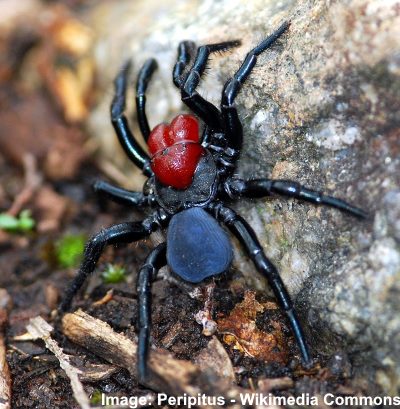
A close up picture of male red-headed mouse spider
Mouse spiders are large red and black spiders with a large shiny red head and bluish-black heart-shaped abdomen. The identifying feature of mouse spiders is their large shiny mouthparts (chelicerae) that are typically red. Depending on the species, the venomous spiders range in size from 0.4” to 1.18” (10 to 30 mm).
Also called the red-headed mouse spider, the male Missulena occatoria has an easily recognizable dark red shiny cephalothorax.
Spider identification: To identify the red-headed mouse spider, look for its bright red jaws and head, glossy black legs, and fuzzy bluish-black abdomen.
Purseweb Spider (Atypus affinis)
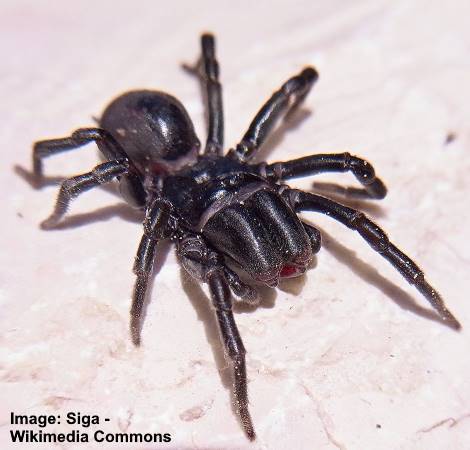
The small black purseweb spider has very large mouthparts
The purseweb spider is a small black spider with a shiny black, bulbous abdomen and a large head with huge chelicerae. The tiny black spider can be easy to confuse for a black widow. However, the small spider lacks the orange or red hourglass marking characteristic of black widows.
Spider identification: The purseweb spider measures 0.6” (15 mm) long and has a shiny black body and robust black legs.
Goldenrod Crab Spider (Misumena vatia)
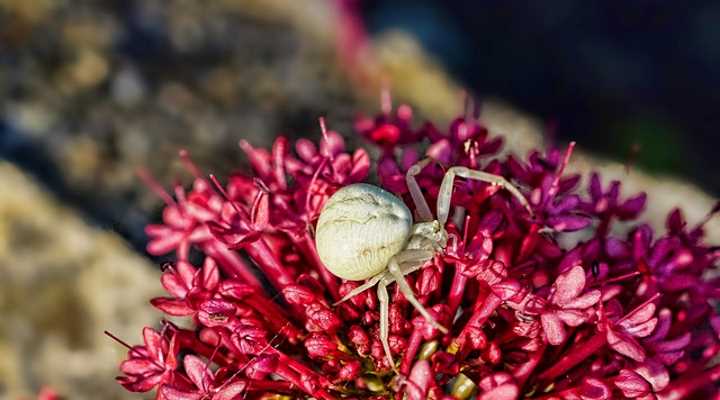
The goldenrod crab spider is identified by its large round white body, although it can turn yellow for camouflage
If you’ve spotted a pure white spider in the garden, the chances are that it’s a goldenrod crab spider. The tiny white spiders have a recognizable egg-shaped, bulging abdomen, a translucent head with greenish bands, and translucent white legs. Goldenrod crab spiders grow around 0.4” (10 mm) long.
A characteristic trait of goldenrod crab spiders is their ability to change color. Despite being a white spider species, they can turn yellow depending on the flowers they live on.
Spider identification: You can identify a goldenrod crab spider by its bulbous white abdomen that looks like a button mushroom and eight legs that look like crab legs.
Caribbean Crab Spider (Misumessus)

The tiny Caribbean crab spider has four long forelegs and tear shaped white body
The Caribbean crab spider looks like the goldenrod spider but has a flattened tear-shaped creamy-white body. The other identifying feature of the Caribbean crab spider is its pale greenish legs, cephalothorax, and chelicerae. The tiny white spiders measure between 0.16” to 0.23” (4 – 6 mm) long.
Spider identification: To identify the Caribbean crab spider, look for the distinctive white abdomen rounded at the bottom and narrower where it joins the cephalothorax. Like other types of crab spiders, this species has a translucent head and legs.
Dancing White Lady Spider (Leucorchestris arenicola)
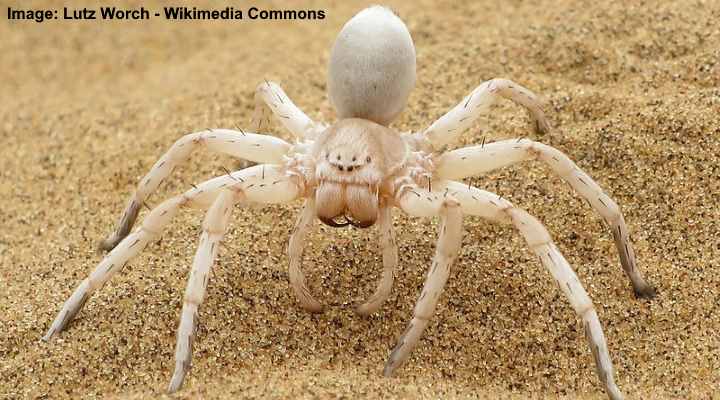
The nocturnal large dancing white lady spider has black spines on its legs
The dancing white lady spider is a nocturnal white spider with a bulbous abdomen, white legs with black spines, and hooked chelicerae. The desert-living white spider is enormous, with a body measuring 5” (130 mm) and a leg span of 10” (250 mm). However, they are rarely seen because they only come out at night in the desert.
Spider identification: The giant dancing white lady spider is all white with an egg-shaped abdomen, black spines on its legs, and a fuzzy pale tan-colored head.
Peacock Spider (Maratus volans)
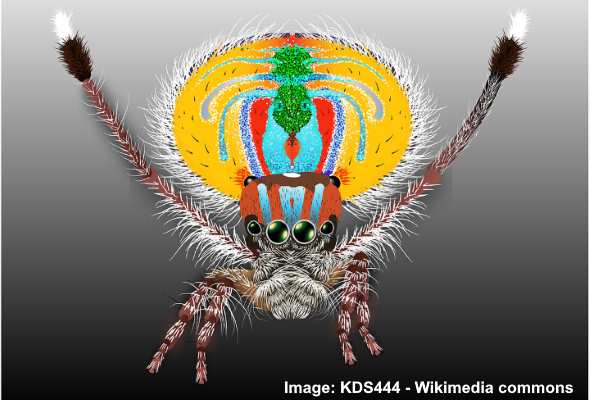
The beautiful mail peacock spider displays its colorful flap during courtship
The peacock spider is one of the most colorful spiders with red, blue, yellow, white, and black colors. The spectacular colors on the male spiders are on flap-like abdominal extensions. The male spiders display these colorful flaps during courtship. On the other hand, female peacock spiders are tiny brown spiders.
Adult male and female peacock spiders measure 0.2” (5 mm) long.
Spider identification: Male peacock spiders are easy to identify when displaying the orange, blue, red, and yellow flaps. Both species of peacock spiders are described as tiny furry spiders.
Colorful Orb-Weaver Spider (Argiope anasuja)
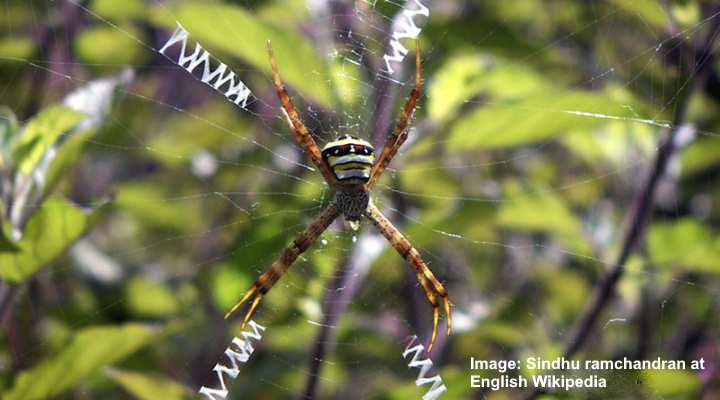
The colorful orb-weaver spider is a black and yellow spider with a stripy abdomen and cross-shaped legs
The Argiope anasuja (black and yellow garden spider) is a harmless colorful spider with white, brown, yellow and black stripes across its pointed triangular abdomen. The spectacular orb-weaver spider is easy to spot in gardens. It sits in the middle of its intricate web in a St Andrew’s cross shape. This colorful spider measures 0.3” to 0.47” (8 – 12 mm) long.
Spider identification: The Argiope anasuja is identified by its heart-shaped striped abdomen, small head, and long grayish-brown stripy and hairy legs.
Giant Golden Orb-Weaver (Nephila pilipes)
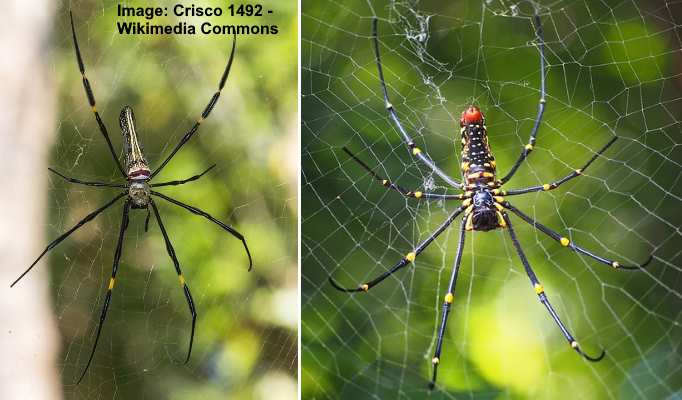
Giant golden orb-weaver top view (left) and underside view (right)
The giant golden orb-weaver is a black spider with yellow markings on its thin, oblong body. The bright yellow stripes on the jet-black body provide a stunning visual contrast. Additional features of this colossal spider are the spindly black legs with yellow dots at the joints.
The appropriately named giant golden orb-weaver grows 1.1” to 2” (30 – 50 mm) and has a ginormous leg span of up to 7.8” (200 mm). This species is one of the largest orb-weaver spiders.
Spider identification: The giant golden orb-weaver has a black or brown, oblong, pointed abdomen, characterized by yellow lateral stripes. The underside of the spider has several yellow dots and an orange circle at its spinnerets.
European Garden Spider (Araneus diadematus)
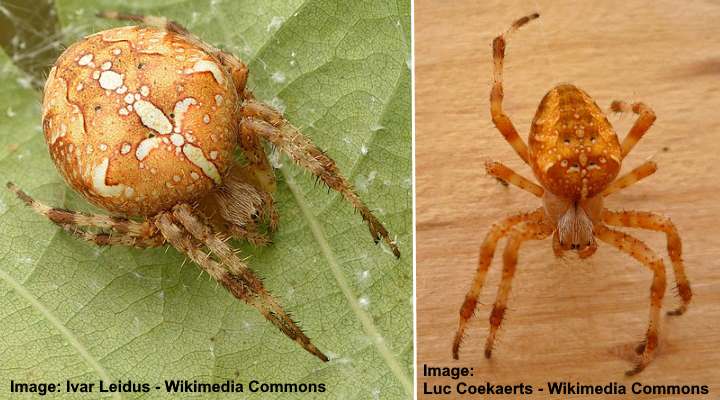
Cross orb-weaver spider: female (left) and male (right)
One of the most distinctive outdoor spiders is the European garden spider. The relatively large brown-orange spider has a bulbous oval abdomen with mottled white, tan, and brown markings. The spider’s eight legs are tan and brown stripes with fine spines. The female adult garden spiders measure 0.26” to 0.8” (6.5 – 20 mm) long.
A characteristic feature of the brown European garden spider is the distinctive white cross on its abdomen. Due to the spider’s unique patterning, it’s sometimes called the cross spider, crowned orb-weaver, or diadem spider.
Spider identification: The European garden spider is easy to identify by its white abdominal marking in the shape of a cross. The egg-shaped orange or brown abdomen is also characterized by mottled white and brown patterns and striped brown and white spiny legs.
Related articles:

